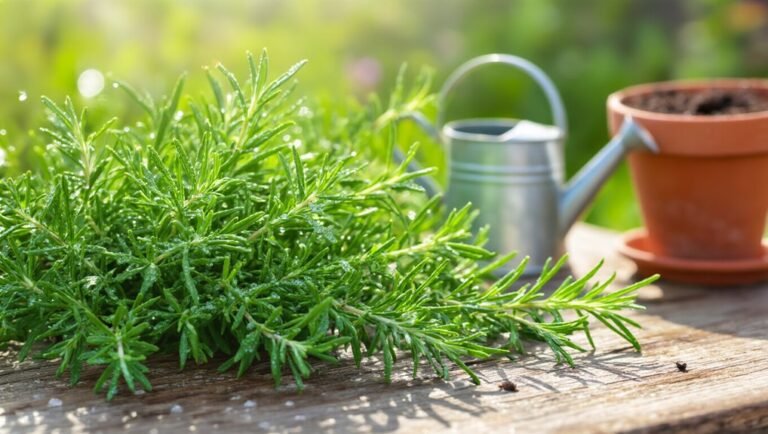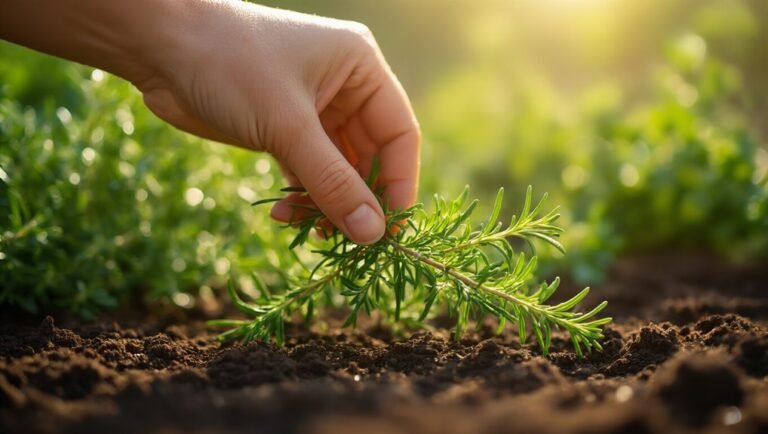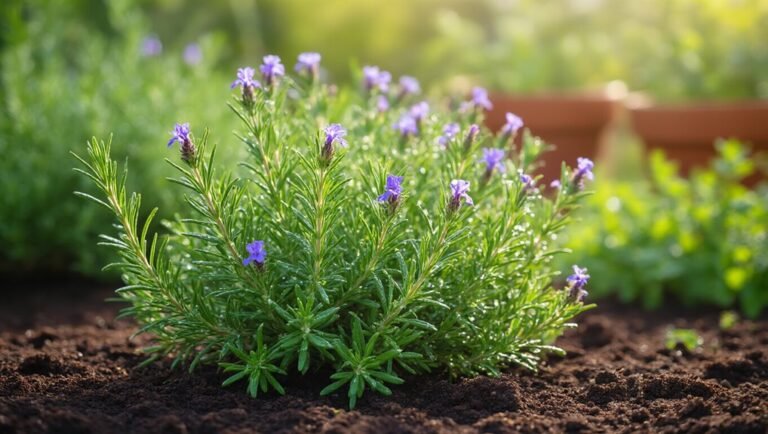To care for your carnations, start with a well-draining soil mix that includes peat moss and perlite. Make sure they get about six hours of sunlight daily, avoiding excessive shade. Water them deeply but infrequently, checking the soil moisture first. Use a balanced fertilizer every 4-6 weeks and trim stems before placing them in water. Regularly inspect for pests and diseases to keep them healthy. Keep going to discover more tips for thriving blossoms.
Key Takeaways
- Choose well-draining soil with a pH between 6.0 and 7.0, and enrich it with compost for optimal growth.
- Ensure carnations receive around six hours of direct sunlight daily, preferably with morning sun for best results.
- Water deeply but infrequently, checking the top inch of soil to prevent overwatering and root rot.
- Conduct regular inspections for pests like aphids and spider mites, and address issues promptly using organic solutions.
- Clean the vase before use, trim stems at an angle, and remove lower leaves to enhance water clarity and prolong bloom life.
Choosing the Right Soil for Carnations
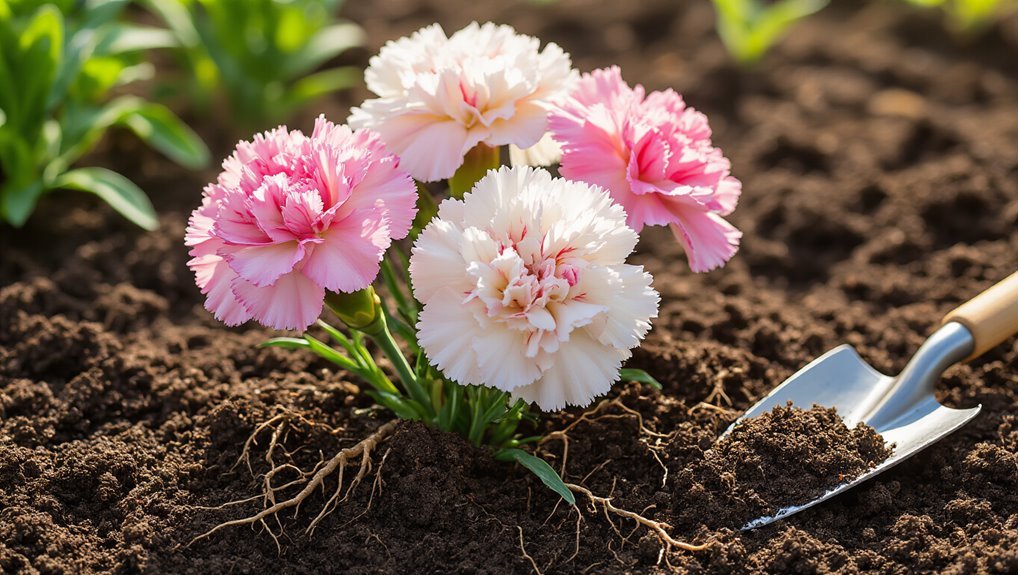
When it comes to growing healthy carnations, choosing the right soil is crucial. You’ll want a well-draining mix that allows the roots to breathe while retaining some moisture. Look for a soil blend that includes elements like peat moss, perlite, or vermiculite. These components help create a light texture and improve drainage.
Aim for a pH level between 6.0 and 7.0, as carnations thrive in slightly acidic to neutral conditions. Before planting, ensure your soil is free of weeds and pests. If you’re using garden soil, consider amending it with compost to boost nutrients. For gardeners seeking an easier way to maintain consistent moisture, self-watering planters can simplify the process and encourage optimal root health.
Regularly check the soil’s moisture level; it should be damp but not soggy. With the right soil, your carnations will flourish beautifully. For the best results, select garden soil designed to help plants thrive and support healthy root development.
Optimal Sunlight Conditions
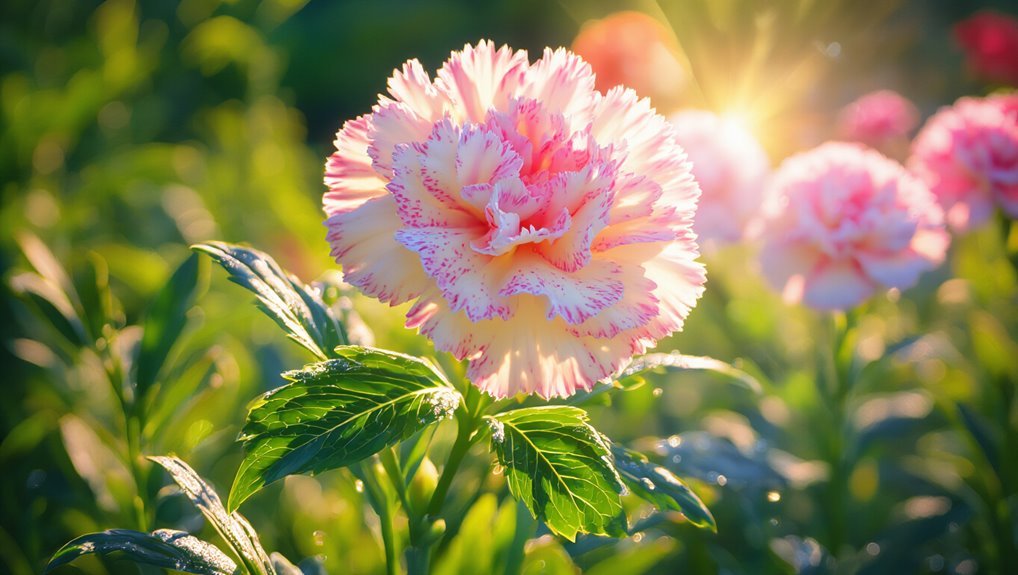
To ensure your carnations thrive, they need plenty of sunlight—ideally, around six hours of direct light each day. Placing them in a spot that receives ample sunlight will help promote healthy growth and vibrant blooms. Using a durable garden hose can make watering your carnations easier, ensuring they receive consistent moisture for optimal growth.
Keep an eye on the following factors to create the perfect environment for your carnations:
- Sunlight Exposure: Position them where they can soak up morning sunlight.
- Shade Consideration: Avoid areas with excessive shade, as it can stunt growth.
- Heat Protection: Be mindful of extreme heat; too much direct sun can cause wilting.
- Rotation: Rotate your pots occasionally to ensure even light distribution.
For best results when planting or maintaining your carnations outdoors, consider using the right garden trowels to make soil preparation and transplanting easier and more efficient.
Watering Techniques for Healthy Growth
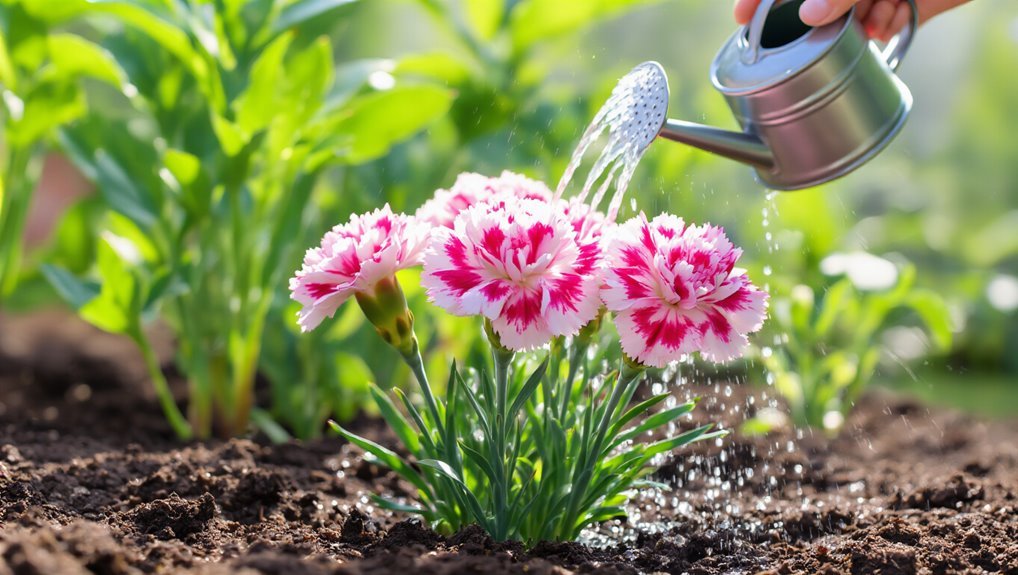
Proper watering is crucial for the healthy growth of your carnations, as it directly impacts their vigor and bloom quality.
To start, water your carnations deeply but infrequently, allowing the soil to dry out slightly between waterings. This encourages deep root growth. One highly effective way to ensure precise and efficient watering is to use a drip irrigation system, which delivers water directly to the roots and helps reduce waste.
Early morning is the best time to water, as it minimizes evaporation and allows foliage to dry before evening.
Be careful not to overwater; soggy soil can lead to root rot. If you’re unsure, check the top inch of the soil—if it feels dry, it’s time to water.
Using a soaker hose or drip irrigation can help deliver moisture directly to the roots, promoting healthier plants.
You can improve your watering routine by using soil moisture sensors to accurately monitor the soil’s moisture level and prevent both over- and underwatering.
Fertilizing Your Carnations
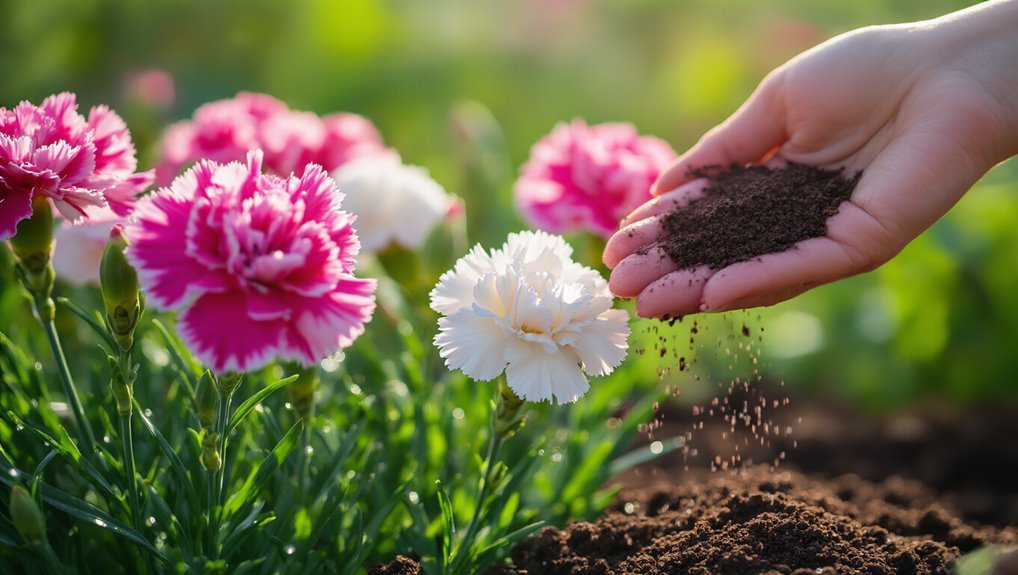
How can you ensure your carnations thrive and produce stunning blooms? Fertilizing is key! Start by using a balanced, water-soluble fertilizer to provide the necessary nutrients. Apply it every 4-6 weeks during the growing season for best results. For gardeners looking for convenience and effective feeding, consider using Plant Fertilizer Tablets as they offer a steady supply of nutrients and are easy to apply.
Here are some tips to keep in mind:
- Use a fertilizer with equal N-P-K ratios (Nitrogen, Phosphorus, Potassium).
- Dilute the fertilizer to half strength to avoid overwhelming your plants.
- Fertilize after watering to prevent root burn.
- Consider a slow-release fertilizer for continuous feeding throughout the season.
Choosing the best plant food options can make a significant difference in the health and vibrancy of your carnations.
Pruning and Deadheading Tips
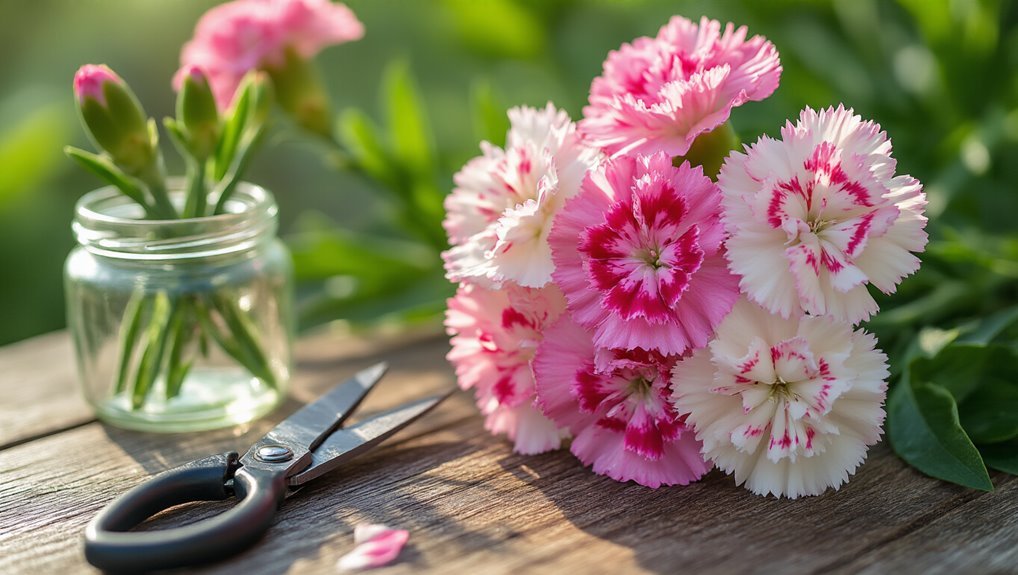
While you may enjoy the vibrant blooms of your carnations, regular pruning and deadheading are essential for keeping your plants healthy and encouraging continuous flowering.
Start by removing faded or wilting flowers right at the base of the stem. This not only improves the plant’s appearance but also prevents seed formation, allowing energy to focus on new growth. For effective maintenance, consider using essential weeding tools to keep the area around your carnations clear of unwanted plants that compete for nutrients.
Prune your carnations lightly in early spring to remove any dead or damaged stems. This helps promote a bushier growth habit.
Make sure to use clean, sharp scissors to avoid damaging the plant.
For best results, consider using pruning shears designed specifically for gardening tasks to make clean, precise cuts and maintain plant health.
Pest and Disease Management
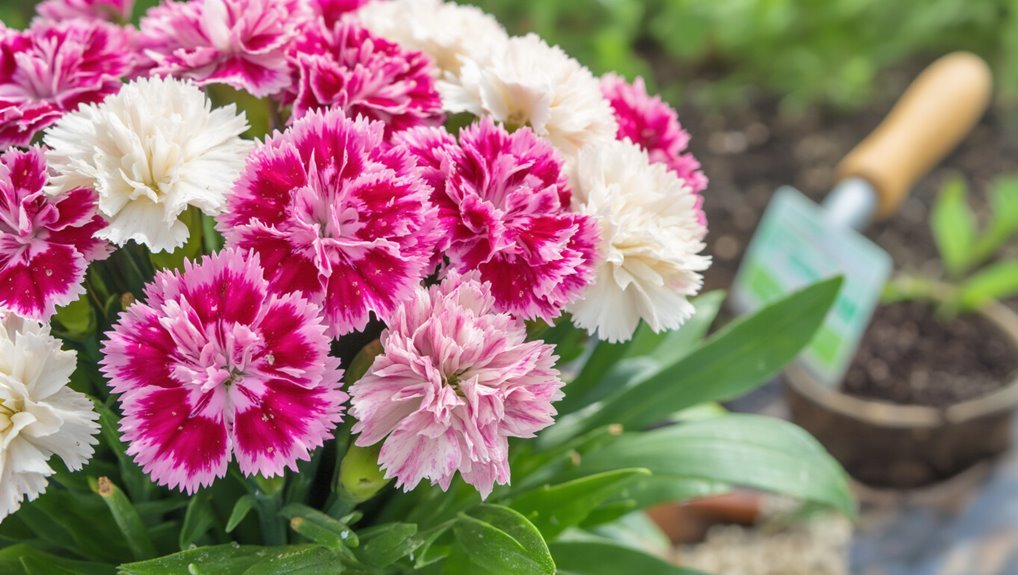
As you nurture your carnations, keeping an eye out for pests and diseases is crucial for maintaining their health.
Regular inspections help you catch issues early. Here are some common pests and diseases to watch for:
- Aphids: These tiny insects suck sap from your plants, causing stunted growth.
- Spider Mites: Look for fine webs and yellowing leaves; they thrive in dry conditions.
- Powdery Mildew: This fungus appears as a white powder on leaves, often due to poor air circulation. You can help prevent outbreaks by using Organic Pest Control Solutions that are gentle on your plants but tough on fungal spores.
- Root Rot: Overwatering can lead to this disease, causing wilting and yellowing.
For effective prevention and treatment, consider using pest control products specifically designed to target these common issues and protect your carnations.
Arranging Cut Carnations for Longevity
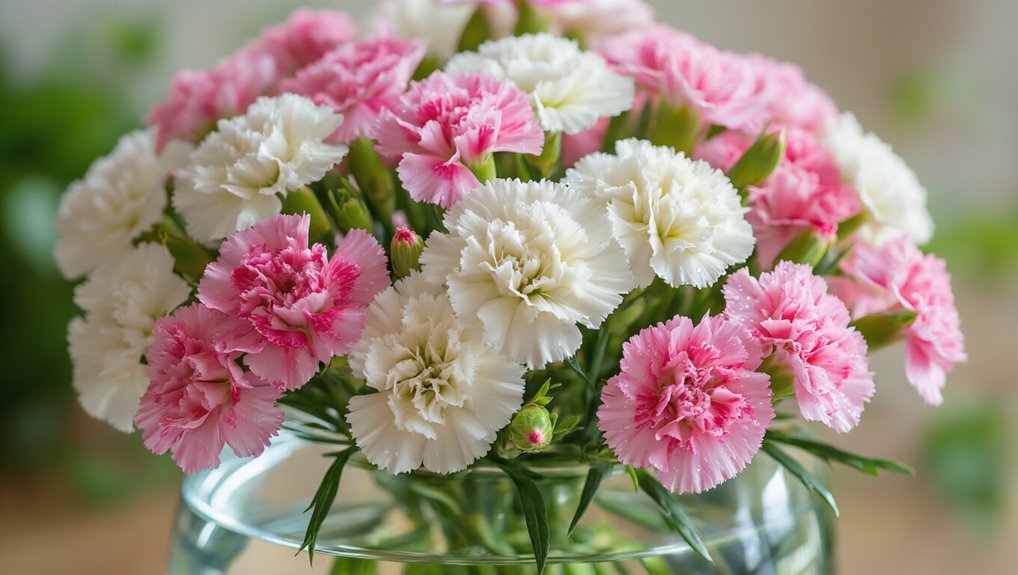
To ensure your cut carnations last as long as possible, start by selecting a clean vase filled with fresh water. Trim the stems at an angle to increase water absorption, and remove any leaves that’ll sit below the waterline. Change the water every few days to keep it fresh and bacteria-free. Place your vase in a cool area away from direct sunlight and drafts. For best results, consider wearing gardening gloves when handling flowers to protect your hands and keep stems clean. Using a watering can with a narrow spout can also help you gently add water to your vase without disturbing your delicate arrangement.
Here’s a quick guide to help you:
| Step | Action | Purpose |
|---|---|---|
| 1 | Clean vase | Prevents bacteria growth |
| 2 | Trim stems | Enhances water uptake |
| 3 | Remove lower leaves | Reduces decay |
| 4 | Change water | Keeps flowers fresh |
| 5 | Keep cool and shaded | Extends life of flowers |
Frequently Asked Questions
Can I Grow Carnations Indoors Successfully?
Yes, you can grow carnations indoors successfully. Just make sure they get plenty of sunlight, maintain moderate humidity, and use well-draining soil. Regular watering and occasional fertilizing will help them thrive in your space.
What Is the Ideal Temperature for Growing Carnations?
When it comes to growing carnations, you’re aiming for a sweet spot between 60°F and 70°F. Keeping them in this range helps them thrive, so you can enjoy their vibrant blooms for longer!
How Long Do Carnations Typically Bloom?
Carnations typically bloom for about two to three weeks, depending on the conditions. To enjoy their beauty longer, keep them in a cool place, provide adequate water, and remove wilted blooms promptly.
Are There Specific Companion Plants for Carnations?
When you think of a harmonious garden, consider planting companion plants like marigolds, snapdragons, or salvia alongside your carnations. They’ll enhance each other’s beauty while deterring pests, creating a flourishing, vibrant display for you to enjoy.
Can I Propagate Carnations From Cuttings?
Yes, you can propagate carnations from cuttings! Take healthy stems, trim them to about six inches, and remove lower leaves. Then, plant them in well-draining soil, keep them moist, and watch them grow.
Conclusion
By following these care tips, you can enjoy vibrant, healthy carnations that brighten your space. You might worry that they’ll be too demanding, but with just a little attention, they reward you with stunning blooms. Imagine walking into a room filled with their sweet fragrance and vivid colors—it’s worth the effort! So don’t hesitate; embrace the joy of nurturing these lovely flowers and watch them thrive, bringing beauty and happiness into your life.
